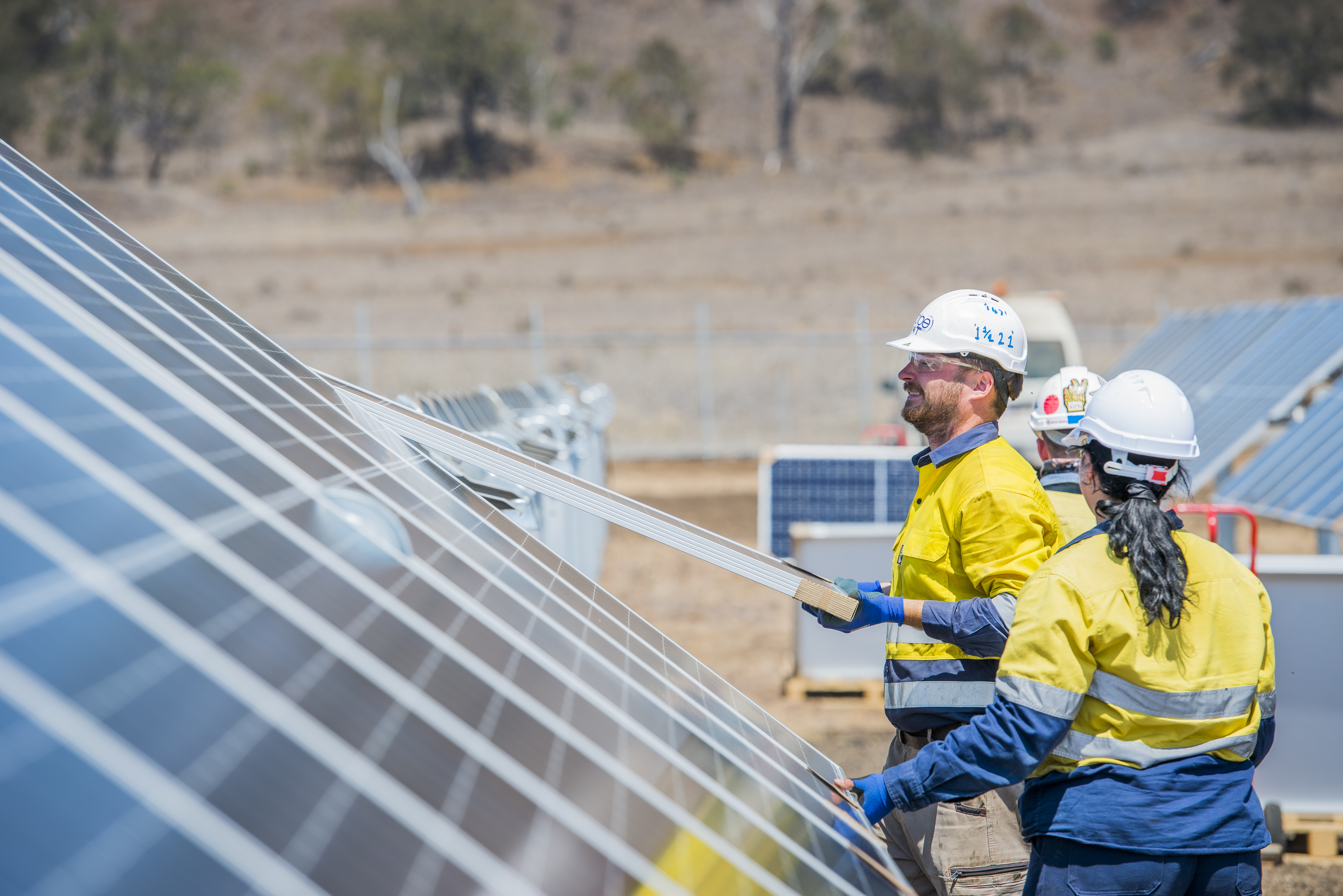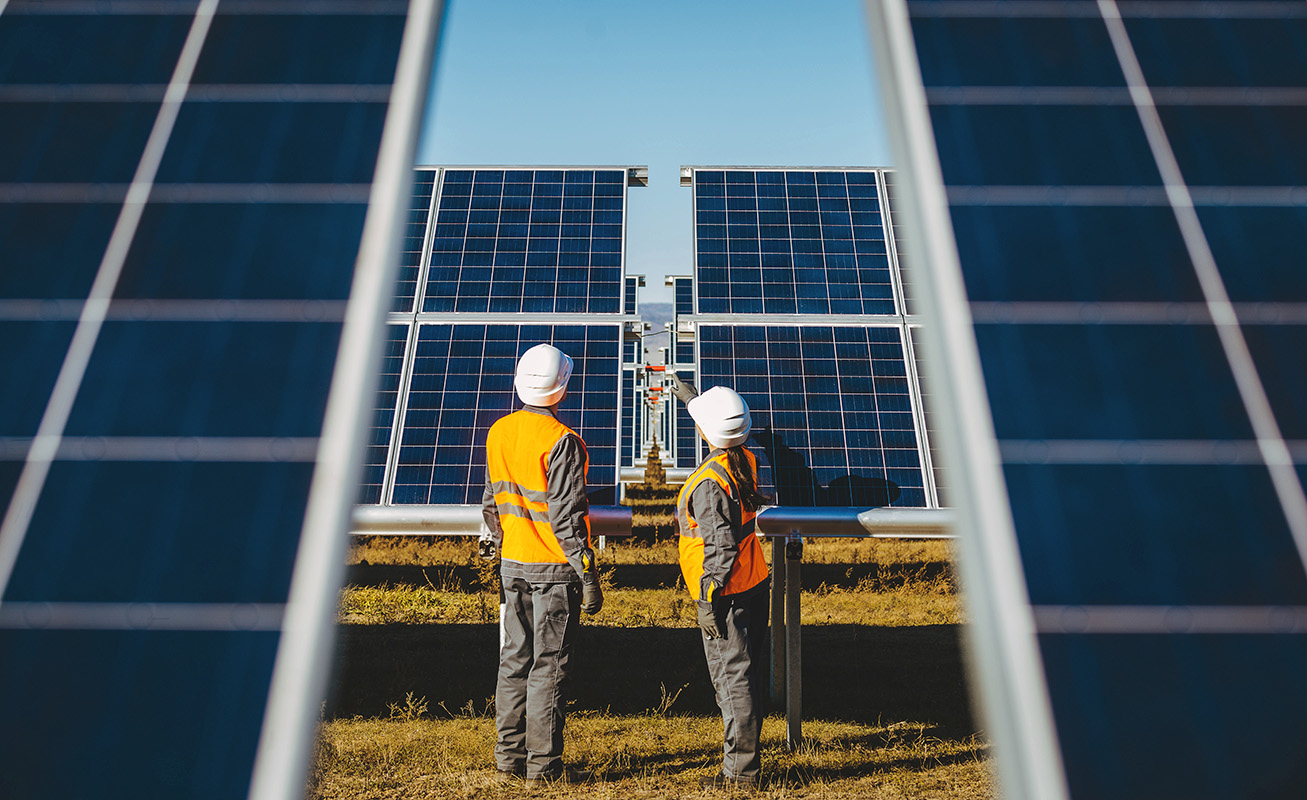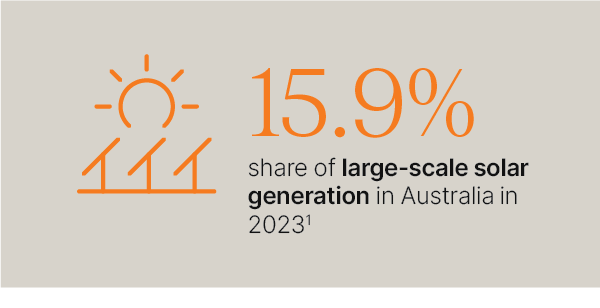
What is a large-scale solar farm?
A large-scale solar farm is a facility that generates electricity from sunlight using photovoltaic solar panels installed over a significant area of land. These solar farms can range from a few megawatts to hundreds of megawatts in capacity. Solar farms are made up of thousands of individual solar panels similar to those you might find on the roof of a house. The panels are attached in rows to a steel frame, which may use tracking technology to rotate through the day to follow the path of the sun.
How do large-scale solar farms work?
Solar panels on the farm capture sunlight and convert it into electricity through the photovoltaic effect. Inverters then convert the direct current electricity generated by the panels into alternating current, which is suitable for use in the electricity grid.
Can solar farms co-exist with agriculture such as grazing and cropping?
Solar energy and agricultural production can be highly compatible and mutually beneficial. Livestock grazing beneath solar panels not only provides an additional income stream for landholders but also offers environmental benefits.
The shade provided by solar panels can reduce heat stress in animals, improve pasture quality, and enhance animal welfare. Grazing by the animals helps reduce maintenance costs. Furthermore, the moisture collected overnight on solar panels drips off to provide strips of green grass, even during dry conditions.
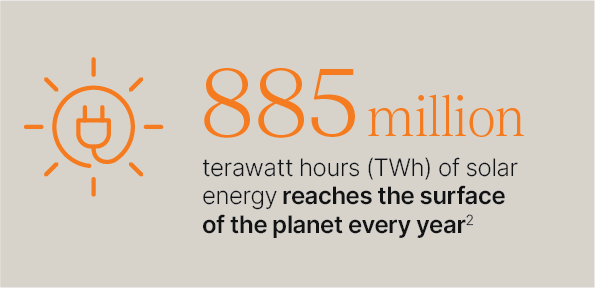
What is the fire risk associated with solar farms?
Solar farms are generally considered safe and operators put in place numerous mitigation measures to reduce the risk of fire. This includes detailed assessments in the planning stage, coordinating with local fire brigades, construction of access roads and active monitoring. All mitigation measures that a project installs or constructs may actually reduce the overall risk of fire in the landscape and enhance community protection from bushfires.
Will hosting or being adjacent to a solar farm impact my public liability insurance?
The Insurance Council of Australia (ICA) has stated that insurers do not have specific concerns related to neighbouring clean energy infrastructure. At the time of writing (3), the Insurance Council is not aware of any instances where its members have been unable to provide insurance coverage or have increased premiums as a result of a farm (or a neighbouring property) hosting energy infrastructure.
Where are large-scale solar farms in Australia?
Large-scale solar farms are located in every state and territory in Australia. Solar farms are most commonly located near electricity transmission lines or substations to enable them to be more easily connected to the electricity grid. Solar farms are typically built on relatively flat land for ease of construction and maintenance and normally on land that has already been cleared, to reduce the environmental impact.
(1) CEC Report 2024 (p19): https://assets.cleanenergycouncil.org.au/documents/resources/reports/clean-energy-australia/Clean-Energy-Australia-2024.pdf (2) International Energy Agency solar energy statistics: NSWEnergyMarket_Solar_Sep2023.pdf (3) December 2024
Renewable energy generated from solar serves an important role in diversifying Australia’s energy mix.
What is the environmental impact of large-scale solar farms?
Large-scale solar farms have a relatively low environmental impact compared to many other forms of energy generation. They produce clean, renewable energy that helps reduce greenhouse gas emissions. Some studies are now finding that solar farms have a positive impact on biodiversity due to the moisture they collect overnight and their potential to reduce erosion. Environmental assessments and studies are conducted before a solar farm is approved to ensure minimal impact on local ecosystems. Measures are taken to protect wildlife, vegetation and water resources.
How is the electricity generated by solar farms used?
The electricity generated by solar farms is typically fed into the electricity grid. It is then distributed to homes, businesses and industries, providing clean and sustainable power.
Are large-scale solar farms eligible for government incentives and subsidies?
In Australia, large-scale solar farms are eligible for various government incentives and subsidies, including Renewable Energy Target (RET) certificates, tax incentives and grants to encourage renewable energy development.
How are large-scale solar farms financed and developed?
Large-scale solar farms are typically financed through a combination of equity investments, debt financing and government incentives. The development process involves securing agreements with landholders to host the project, conducting a range of detailed studies, assessment of impacts by government agencies, obtaining the necessary permits/licences and then constructing the solar facility.
Can solar farms be paired with energy storage?
Yes. Many new solar farms are incorporating energy storage systems, including batteries, on the same site to store excess energy during the day, for use during cloudy periods or at night.
What is the lifespan of a large-scale solar farm?
Large-scale solar farms typically have a lifespan of 25-30 years, during which they can continue to generate electricity efficiently with regular maintenance.
Can local communities benefit from large-scale solar farms?
Solar farm projects create dozens, or even hundreds of jobs during construction and provide ongoing revenue through lease payments to host landowners. Some projects also contribute to local community benefit funds.
How does the weather affect the performance of solar farms in Australia?
Solar farms perform best under clear, sunny conditions, but they can still generate electricity on partly cloudy days. Performance may be reduced during heavy rain, storms, or extreme heat.
Are there regulations regarding decommissioning and land restoration after a solar farm reaches the end of its life?
The agreement between a solar farm owner and a landholder provides a contractual requirement for the solar farm owner to decommission the project at the end of its life. This typically involves restoring the land to its original or an improved state. This includes removing equipment and structures, but landholders may want access tracks or fencing to be left on-site.
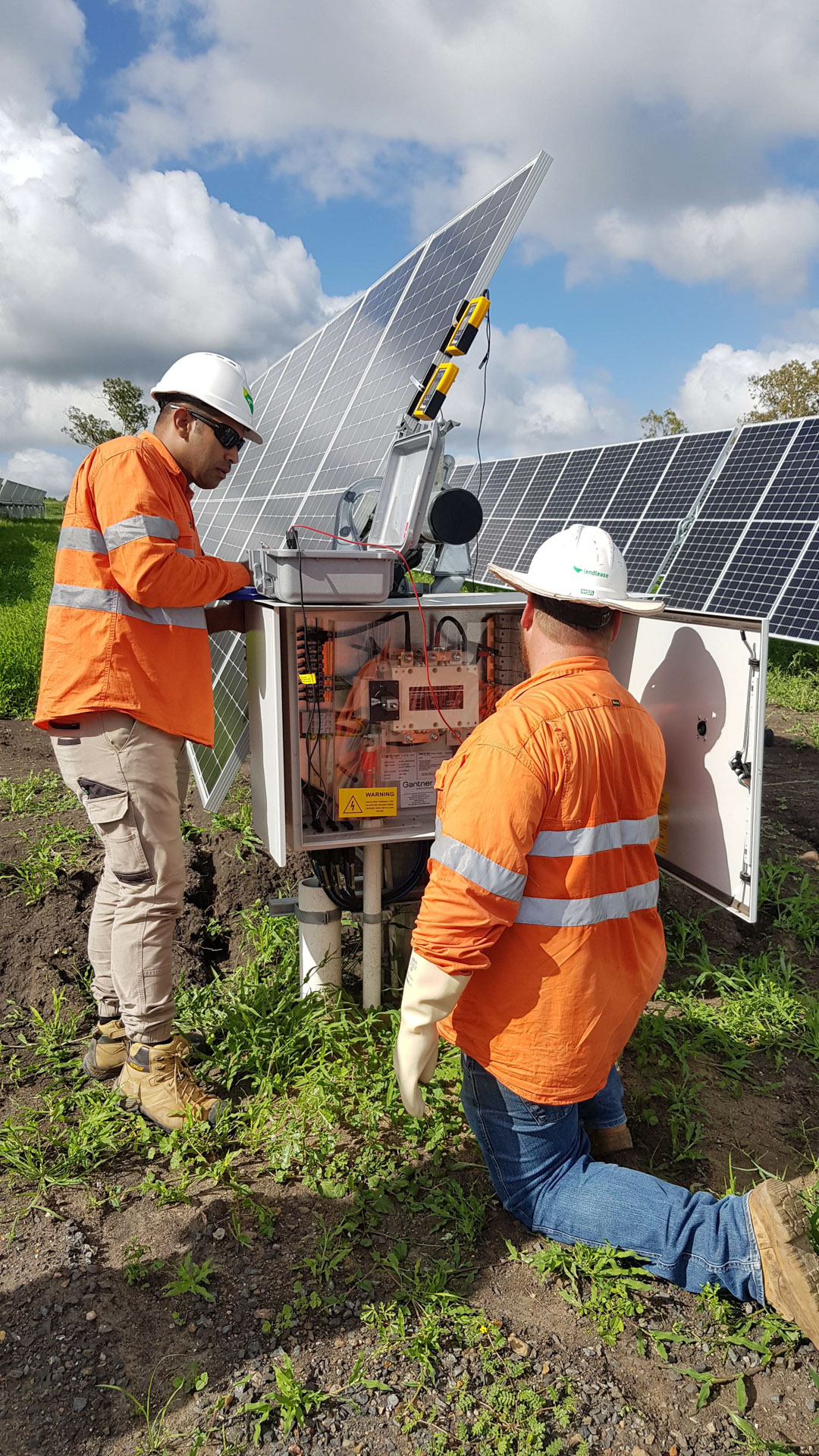
Large-scale solar employment FAQs
How do large-scale solar farms contribute to local job creation?
Large-scale solar farms create jobs during various phases, including development, construction and ongoing operation and maintenance. Local communities often benefit from employment opportunities in these phases. Most jobs are created during the construction phase – dozens to several hundred, depending on the size of the solar farm.
What types of jobs are available in the solar farm industry?
The solar farm industry offers a wide range of job opportunities, including project management, engineering, construction, electrical work, earthworks and trenching, maintenance, security, land management and administrative roles.
Are there training and educational programs to prepare local residents for jobs in the solar industry?
Yes, some large-scale solar farm projects collaborate with local educational institutions and vocational training centres to provide training programs tailored to the needs of the industry.
How do solar farms benefit the local economy beyond job creation?
Solar farms inject money into the local economy through land lease payments, property taxes and the purchase of goods and services from local businesses, including construction materials and equipment
Do solar farms have agreements in place to procure goods and services locally?
Many solar farm projects have local procurement policies in place, prioritising the use of local suppliers and services to support the surrounding community and boost the local economy.
Are there long-term economic benefits for local communities from solar farm projects?
Yes; beyond the initial construction phase, solar farms continue to provide revenue through property taxes and lease payments to landowners. This revenue can support local infrastructure and services.
Are there community engagement initiatives associated with solar farm projects?
Many solar farm developers engage with local communities through public consultations, community benefit funds, and partnership programs to ensure the local population benefits from the project's success.
Are there opportunities for small and medium-sized enterprises (SMEs) in the solar farm industry?
Yes; SMEs can play a crucial role in supplying specialised services, equipment, and materials needed for solar farm projects. Developers often seek partnerships with SMEs to support project construction and operation.
Top 5 clean energy facts
The clean energy transition will create
66,000 jobs by 2030
As a windswept and sun-drenched land
Australia has an abundance of cheap and reliable renewable energy
Clean energy projects will deliver between
$7.7 billion - 9.7 billion in direct payments to farmers and nearly $2 billion to regional communities land councils by 2050
Clean energy is already supplying more than
40% of Australia’s electricity
Australia is already feeling the effects of a changing climate, with more intense heatwaves, droughts, floods, fires, ocean acidification and rising sea levels.
Clean energy is the best way to reduce emissions and prevent the worst impacts of climate change
